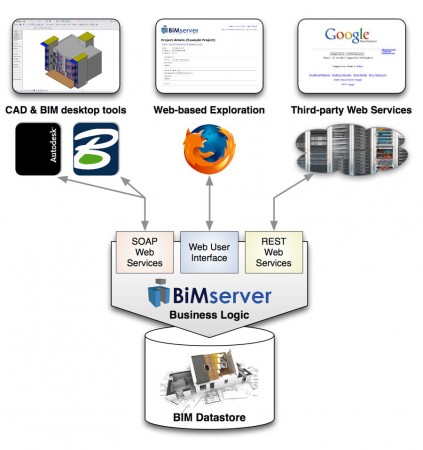A group of open-source programmers and researches involved in architectural CAD and building information modeling (BIM) tools have developed a working tool called BIMserver. Known as the BIMserver Project from TNO and the University of Eindhoven in the Netherlands, the group’s efforts propose to radically alter the landscape for computerized applications in the AEC (architecture, engineering and construction) industries.
BIMserver: Understanding the Paradigm Shift
Today BIM and CAD tools essentially store data on local workstations and local area network (LAN) servers. However, the idea behind BIMserver is that the data inside a BIM should be stored entirely on a centralized server accessible to the Internet. It could also be hosted out on the cloud as a service. This idea is not new and the team behind BIMserver acknowledge that. What is new is that the technology is ready to move beyond the research lab into production software.
BIMserver interfaces with client-side BIM, CAD and analysis tools via a set of SOAP and REST web services. All client applications read from, and write to, the same digital [BIM] model. Compared to today’s various client-sided and server-sided BIM tools, BIMserver users are always working with the latest information and it is not necessary for them to confirm this.
An interesting aspect of BIMserver as discussed here at Stress-Free.co.nz is that third-party web services, like companies that manufacturer products for buildings (eg: doors, windows, floor materials, lighting, etc.) could enable a direct link to data in the BIM under BIMserver since the building model exists as a live entity — much like the databases behind Facebook for example. What users find when they connect to Facebook is the very latest “state” of the unified database as updated by its many participants.
Using REST web services manufacturers could provide live-linked data on objects (again like doors for example) that update with new price information and schedule of delivery availability information without the user taking action to update that information. Today BIM tools require the participants feed this information into the building model and then constantly maintain it in order to keep information current.
BIMServer: Free, Java-based and runs on Mac
Today BIMserver is free and released under the GPLv3 open-source license. Besides the two sponsors listed above, CSIRO and the VTT are investigating ways to participate and nine businesses have expressed interest in making compatible client software to plugin to BIMserver.
BIMserver is written entirely in Java and can be deployed to any modern Java web application server or run as a standalone application using the light-weight Jetty library. BIMserver can therefore run on Windows, Mac OS X and Linux, and in a production environment it could be deployed from within Tomcat, JBoss or GlassFish Java web application servers.
Client applications interact with BIMserver through a SOAP web service interface that implements the Building Information Exchange Protocol (BIEP), which is a new protocol from the Open Source BIM Initiative.
Those behind the BIMserver project acknowledge that while the technology concept behind it is very promising its adoption within AEC is fraught with challenges imposed by the current paradigm of a workstation-centric culture.
BIMserver.org is the official site for BIMserver, the open-source project, and about a week ago the first public release came online — version 0.1 release candidate 1. You can download the software here as well.
[Ed. note: This article has been updated from its original publication time. 2 Mar 2009.]




Reader Comments
[…] standards are the main driver for innovation. The open source BIMserver could very well be the next driver for innovation in the AEC […]
Comments are closed.